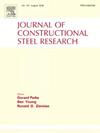钢-混凝土复合墙体在火灾中的行为、设计和性能
IF 4
2区 工程技术
Q1 CONSTRUCTION & BUILDING TECHNOLOGY
引用次数: 0
摘要
本文利用ABAQUS软件中的有限元(FE)建模,基于现有的钢-混凝土组合墙(SCC)防火试验数据库,研究了钢-混凝土组合墙(SCC)在机械和火灾联合荷载下的性能。对234个有限元模型进行了广泛的参数分析,提供了对关键设计参数的深入了解,包括初始偏心、壁长细比、核心混凝土厚度、核心载荷比和一系列火灾暴露条件。有限元模型的顺序耦合热-力分析每隔1分钟进行一次。它包括传热分析以建立温度场,然后是增量静态应力-应变分析以确定载荷-位移响应。模拟结果表明,初始偏心为核心混凝土厚度的5%及其方向对耐火期(FRP)有显著影响。在单面火灾情况下,用于保温的FRP与核心混凝土厚度呈线性相关,并且与全面或双面火灾情况相比,墙体的FRP更长。此外,较高的岩心荷载比和壁长细比显著降低FRP。通过对模型结果与设计标准的详细比较,确定了预测SCC墙体FRP的现行标准的局限性。因此,从模型结果的最佳拟合分析中得出的一系列新的设计方程被提出,以提供更可靠的FRP估计。本文将有助于未来设计准则的改进,以评估SCC墙的耐火能力。本文章由计算机程序翻译,如有差异,请以英文原文为准。
Behaviour, design and performance of steel-concrete composite walls in fire
This paper utilizes finite element (FE) modelling in ABAQUS software to investigate the behaviour of steel-concrete composite (SCC) walls under combined mechanical and fire loadings, based on an existing database of SCC wall fire tests. An extensive parametric analysis of 234 FE models is implemented, which offers deep insight into the critical design parameters, comprising the initial eccentricity, wall slenderness, core concrete thickness, core load ratio, and a range of fire exposure conditions. The sequential coupled thermo-mechanical analysis of the FE models is conducted in one-minute intervals. It includes a heat transfer analysis to establish the temperature field, followed by an incremental static stress-strain analysis to determine the load-displacement response. The simulation results show that an initial eccentricity of 5 % of the core concrete thickness and its direction have a significant impact on the fire resistance period (FRP). Under one-sided fire exposure, the FRP for insulation correlates linearly with the core concrete thickness, and the wall exhibits longer FRP when compared with all-sided or two-sided fire cases. Moreover, the higher core load ratios and wall slenderness considerably lower the FRP. Through a detailed comparison of the modelling results with design standards, the limitations of prevailing standards for predicting the FRP of SCC walls are identified. Therefore, a series of new design equations derived from the best-fit analysis of the modelling results are proposed to offer more reliable estimates of the FRP. This paper will contribute to the future refinement of design guidelines for assessing the fire-resistance capacity of SCC walls.
求助全文
通过发布文献求助,成功后即可免费获取论文全文。
去求助
来源期刊

Journal of Constructional Steel Research
工程技术-工程:土木
CiteScore
7.90
自引率
19.50%
发文量
550
审稿时长
46 days
期刊介绍:
The Journal of Constructional Steel Research provides an international forum for the presentation and discussion of the latest developments in structural steel research and their applications. It is aimed not only at researchers but also at those likely to be most affected by research results, i.e. designers and fabricators. Original papers of a high standard dealing with all aspects of steel research including theoretical and experimental research on elements, assemblages, connection and material properties are considered for publication.
 求助内容:
求助内容: 应助结果提醒方式:
应助结果提醒方式:


